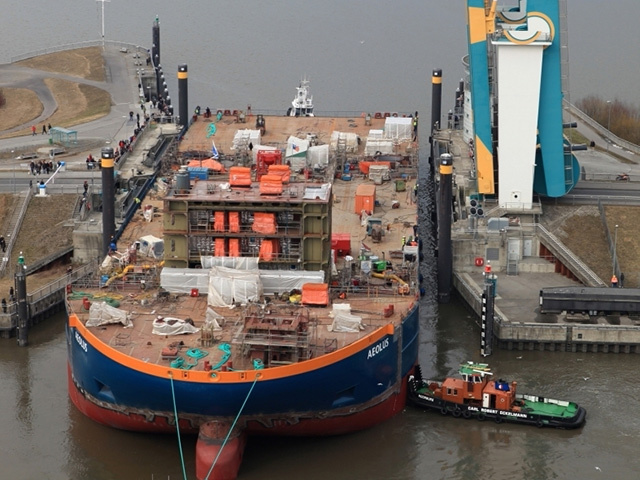
A windfarm construction vessel that got caught up in the collapse of the German shipyard Sietas, will apparently be delivered to Dutch company Van Oord in the summer.
The Aeolus was originally ordered in 2010 and is currently noted by Van Oord as becoming operational “in the spring of 2013”.
The 140m length overall by 38m breadth hull is reported to be complete and fabrication of the superstructure is reported to be under way.
Sietas crashed early last year and put into administration. Last summer, an offer for the yard was made by Dutch interest Vekta but did not conclude. Creditors of the yard wanted a deal but it was conditional on Van Oord sticking to its original commitment of having two vessels built. However, that was contingent on a firm investment decision for the EnBW Hohe See offshore windfarm. That did not happen.
Meanwhile the yard was kept running and the build progressed.
According to insolvency administrator Berthold Brinkmann, it was important that the order was completed. Sietas had specialist skills, moreover it had also designed the vessel.
Some 400 workers were involved in the hull fabrication process. The aft and fore-bodies of the hull were fabricated in just six weeks based on nine modules.
The vessel is being completed while lying afloat. This includes installing a 900-tonne NMF pedestal crane. The hope is that sea trials will start at the end of June.
The understanding is that the vessel’s four massive jack-up legs will not be fitted until after the initial sea trials.
The vessel’s designed transport capacity is 6,500 tonnes and it is designed to jack-down in water depths to 45m (leg length is 84m).
Designed service speed of the 10,000kW diesel-electric vessel is 12 knots.
Van Oord has a significant track record in windfarm construction. A current example is the Teesside Offshore Windfarm where foundation work was completed in May last year. Turbine installation work is thought to be completed.
Van Oord also has an EPC contract to install the cables for the Dan Tysk project. This means that they will be responsible for the engineering, procurement and installation of the infield cables. The preparatory works started in 2011, and the offshore construction will be carried out this year.